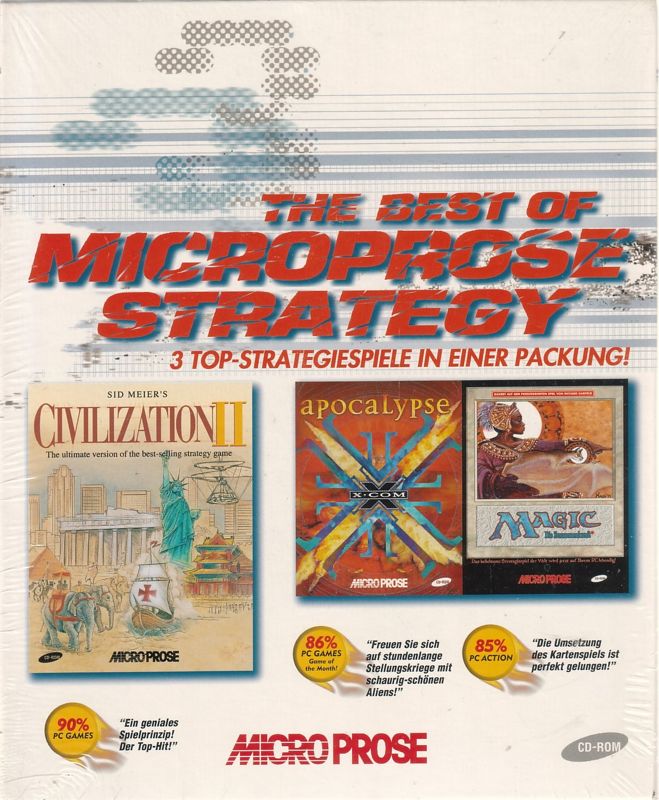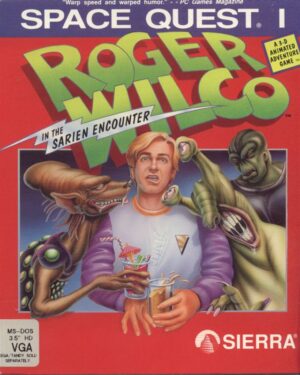Retro Replay Review
Gameplay
The Best of Microprose Strategy compilation brings three distinct gameplay experiences under one roof, and each title remains as captivating today as when it first debuted. In Magic: The Gathering, players dive into deck-building wizardry, crafting customized card collections to outsmart opponents in turn-based duels. The simple elegance of resource management—land cards, creature summoning, and spellcasting—ensures a strategic depth that rewards both planning and adaptability.
(HEY YOU!! We hope you enjoy! We try not to run ads. So basically, this is a very expensive hobby running this site. Please consider joining us for updates, forums, and more. Network w/ us to make some cash or friends while retro gaming, and you can win some free retro games for posting. Okay, carry on 👍)
Sid Meier’s Civilization II offers a sprawling grand strategy sandbox, tasking you with guiding an entire civilization from its humble beginnings through the ages. Research trees, diplomatic negotiations, and city micromanagement create a continuous balancing act between short-term gains and long-term empire building. The variety of victory paths—cultural, scientific, diplomatic, and military—ensures that no two campaigns feel identical, and each decision resonates across centuries.
X-COM: Apocalypse injects a pulse-pounding tactical layer to the collection, pitting you against an alien invasion in a futuristic metropolis. Sieving through city sectors, managing soldier inventories, and conducting surgical strikes against extraterrestrial threats demand both strategic foresight and reactive quick thinking. The blend of base management, research, and perilous ground missions delivers a tense, immersive loop that contrasts beautifully with the other two titles.
What unites these games is their shared heritage in strategic decision-making and resource allocation. Whether you’re calculating the odds of drawing your next key card, expanding cities across continents, or flanking alien aberrations in cramped corridors, The Best of Microprose Strategy offers a masterclass in cerebral gameplay that stands the test of time.
Graphics
While modern gamers may find the pixel art and 2D sprites of the Microprose classics nostalgically dated, the visuals still possess a distinctive charm and clarity. Magic: The Gathering showcases its iconic card artwork in all its original glory, with high-contrast frames that make each creature and spell pop off the screen. Animations are minimal by today’s standards, but they draw your eye exactly where it needs to be—on the next tactical move.
Civilization II’s isometric map tiles and simple unit icons belie a remarkable amount of information conveyed at a glance. Terrain types, city statuses, and unit positions are all easily distinguished, ensuring that no crucial detail ever gets overlooked during empire expansion. The color palette may not dazzle like contemporary 3D engines, but its readability and functional design continue to serve the gameplay perfectly.
X-COM: Apocalypse ups the ante with a dark, atmospheric cityscape rendered in detailed 2D tiles. Alien egg sacs, security cameras, and neon signs are meticulously placed to build a sense of urban dread. The topdown view may be static, but the grime-soaked corridors and high-tech labs feel alive thanks to clever use of lighting and color variations.
Overall, this compilation doesn’t hide behind graphical bells and whistles—it embraces its period-correct aesthetics. The art direction remains coherent across the three titles, reminding players that strategy games often rely more on clarity and usability than photorealism.
Story
Magic: The Gathering weaves its narrative subtly through card flavor text and tournament lore. Although there’s no overarching campaign, each card cycle hints at conflicts between planeswalkers, ancient dragons, and eldritch horrors. This decentralized storytelling allows players to craft their own narrative arcs as they build themed decks and stage dramatic showdowns.
In Civilization II, the story unfolds as a personal odyssey through time. You witness the rise and fall of empires, negotiate with historic leaders, and race toward future tech. While there’s no fixed protagonist, the emergent narrative you create—whether forging a Pax Romana or shepherding humanity to the stars—feels uniquely yours. The game’s tooltips and advisor lines sprinkle in historical anecdotes that enrich the journey without bogging down the pacing.
X-COM: Apocalypse presents perhaps the most concrete storyline, set in the domed megacity of Mega-Primus. As commander of X-COM, you uncover layers of conspiracy involving mutagens, underground crime lords, and alien infiltration. The campaign structure—divided into sectors—provides a clear narrative progression, with plot twists that keep tension high from the first abduction to the final showdown.
Together, these titles showcase three different storytelling philosophies: emergent, open-ended, and structured. They complement each other by highlighting how strategy games can be narrative canvases, whether your story is etched by card plays, civilization chronicles, or alien skirmishes.
Overall Experience
The Best of Microprose Strategy is a testament to the golden age of thoughtful game design. Each title retains a razor-sharp focus on player choice and strategic depth, offering hundreds of hours of engagement. Whether you’re a returning veteran seeking a flood of nostalgia or a newcomer curious about gaming history, this compilation delivers robust content at a remarkably accessible price point.
The interface across all three games has been slightly modernized for compatibility with contemporary operating systems, resulting in smoother installations and more stable performance. Mouse-driven controls feel intuitive, and keyboard shortcuts speed up routine tasks without sacrificing the old-school charm. Multiplayer lobbies for Magic: The Gathering and Civilization II still foster active communities, proving these games haven’t been left behind by the pack.
Beyond the raw gameplay mechanics, there’s a cohesive design philosophy that binds these titles: deep, rewarding choices that resonate long after you quit the game. Whether you’re negotiating peace treaties, drawing lands to cast a crushing spell, or storming alien nests, success hinges on careful planning, adaptability, and foresight.
In summary, The Best of Microprose Strategy is an essential collection for any strategy enthusiast’s library. It bridges the gap between classic and modern sensibilities, showcasing timeless design in an easily digestible package. With three powerhouse titles from Microprose’s storied past, this compilation earns a spot on the shelf of gamers who relish intellectual challenges and strategic mastery.
 Retro Replay Retro Replay gaming reviews, news, emulation, geek stuff and more!
Retro Replay Retro Replay gaming reviews, news, emulation, geek stuff and more!




Reviews
There are no reviews yet.